Neural Network vs AI: What’s the Difference?

In computer technology discourse, you might often find artificial intelligence and neural networks mentioned as if they were the same. This, however, isn’t exactly correct. Our article aims to clarify these terms, enhancing your technical understanding.
On this page
The Technologies Behind Artificial Intelligence
Artificial Intelligence (AI) is an expansive concept, covering various technologies that allow machines to emulate human intelligence. Neural networks represent just one facet of AI.
In addition to neural networks, artificial intelligence incorporates technologies such as:
- Machine learning, which develops algorithms capable of learning from extensive datasets.
- Logical programming, aimed at solving problems in planning, reasoning, and forecasting.
- Genetic programming, addressing issues that require an understanding of genetics and biological evolution.
- Game theory, essential for creating strategies and making decisions amidst uncertainty.
The key difference between AI and neural networks is their breadth: AI represents a diverse array of technologies, while neural networks are a specific type of structure within the AI framework.
The Workings and Principles of Neural Networks
Neural networks stand apart from regular computer programming, resembling dynamic mathematical models that simulate the functioning of the human brain. Their output, much like human thinking, is often unpredictable.
A neural network comprises a series of interconnected units called neurons. Each neuron receives input signals from its counterparts, processes these signals, and then generates an output.
Key Components of a Neural Network
The fundamental elements of a neural network include:
- Input Data: This is the raw information fed into the network and can take various forms, such as numbers, symbols, or images.
- Neurons: They are the critical building blocks of the network. Each neuron has several input connections and a single output connection.
- Neural Network Weights: These weights are numerical factors that influence the strength and speed of signal transmission between neurons. They are adjustable and are refined during the network's learning phase to optimize performance.
Weights: Indicators of Neuronal Connectivity. Source: towardsdatascience.com
4. Summation Function: This function combines input data with their weights to produce a total sum, which is then fed into the network.
5. Activation Function: It determines how the processed signals are transmitted between neurons, altering them as needed. This function is crucial in deciding if a neuron will be activated.
Training of Neural Networks
Neural networks undergo training using data sets that include both input information and the required output as determined by the operator. The goal during training is for the network to identify neuron weight values that enable it to generate appropriate output data from the incoming flow of information.
The common method for training neural networks is error backpropagation, which encompasses several steps:
- Feeding input data into the network.
- The network processes this data to produce an output.
- This output is compared with a pre-determined, correct result.
- If discrepancies arise between the input data and the processed output, the error information is relayed back through the network, affecting all neurons.
- Subsequently, the connections between neurons are adjusted to prevent such errors in future operations.
While training can be extensive and demanding, a well-tuned network is capable of producing highly accurate outputs based on specified input data.
Different Types of Neural Networks
There are several types of neural networks, each suited for different tasks:
- Functional Networks: Used for tasks that involve intricate mathematical computations.
- Recognition Networks: Designed to identify objects, phenomena, languages, and speech from images and audio files.
- Reinforcement Learning Networks: These networks learn from experiences and are used in decision-making tasks, such as in gaming or educational applications.
Applications of Neural Networks
Neural networks find applications in a wide array of fields. Some familiar examples include:
- Computer vision for recognizing objects and faces (Worldcoin);
- Pattern detection (trading bots like BabyAGI and AutoGPT);
- Spoken language recognition of humans and animals (Soundwel);
- Machine translation services;
- Text generation (ChatGPT);
- Interactive gaming (Story Games AI).
This list is not exhaustive; neural networks continue to expand their applications, solving an array of complex tasks across different domains.
The content on The Coinomist is for informational purposes only and should not be interpreted as financial advice. While we strive to provide accurate and up-to-date information, we do not guarantee the accuracy, completeness, or reliability of any content. Neither we accept liability for any errors or omissions in the information provided or for any financial losses incurred as a result of relying on this information. Actions based on this content are at your own risk. Always do your own research and consult a professional. See our Terms, Privacy Policy, and Disclaimers for more details.


























